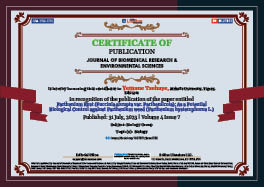Yemane Tsehaye* and Tesfakiros Semere
Volume4-Issue7
Dates: Received: 2023-07-13 | Accepted: 2023-07-31 | Published: 2023-07-31
Pages: 1166-1169
Abstract
Parthenium (Parthenium hysterophorus L.), the invasive weed of global significance, have a direct and indirect impact on human and animal health as well as the overall ecosystem health. Since its introduction to Ethiopia and the Tigray region, it rapidly covers millions of hectares of crop fields. Different biological control options were tested in many countries including Ethiopia, that ranging from fungus inoculation to the introduction of insect pests (bioagents) and two bioagents, the leaf-feeding beetle (Zygogramma bicolorata) and stem-boring weevil (Listronotus setosipennis) were reported to have better performance. Nevertheless, susceptibility of the bioagents to weather variability and predators were among the important factors that halts the effectiveness of the bioagent based biological control. In the Tigray region, the native pathogen, parthenium rust(Puccinia abrupta var. partheniicola) showed very promising effect against the noxious weed, parthenium, and proved to be reliable. In field condition, disease incidence that ranges between 20-100% was observed. As a result of the pathogenicity effect of the parthenium rust, symptoms like leaf and flower defoliation, chlorosis, necrosis, and stunted vegetative growth, and failure of seed production have been portrayed. The future use of uredospore suspensions of the parthenium rust as foliage application and as a mycoherbicide, and development of tolerant crop varieties via breeding are discussed.
FullText HTML
FullText PDF
DOI: 10.37871/jbres1782
Certificate of Publication

Copyright
© 2023 Tsehaye Y, et al. Distributed under Creative Commons CC-BY 4.0
How to cite this article
Tsehaye Y, Semere T. Parthenium Rust (Puccinia abrupta var. Partheniicola): As a Potential Biological Control against Parthenium weed (Parthenium hysterophorus L.). 2023 July 31; 4(7): 1166-1169. doi: 10.37871/jbres1782, Article ID: JBRES1782, Available at: https://www.jelsciences.com/articles/jbres1782.pdf
Subject area(s)
References
- Picman J, Picman AK, Autotoxicity in Parthenium hysterophorus and its possible role in control of germination. Biochemical Systematics and Ecology. 1984;12(3):287-292.
- Adkins S, Shabbir A. Biology, ecology and management of the invasive parthenium weed (Parthenium hysterophorus L.). Pest Manag Sci. 2014 Jul;70(7):1023-9. doi: 10.1002/ps.3708. Epub 2014 Jan 24. PMID: 24430973.
- Mao R, Shabbir A, Adkins S. Parthenium hysterophorus: A tale of global invasion over two centuries, spread and prevention measures. J Environ Manage. 2021;279:111751.
- Tamado T, Milberg P. Weed flora in arable fields of eastern Ethiopia with emphasis on the occurrence of Parthenium hysterophorus. Weed Research. 2000;40:507-521.
- Boja M, Girma Z, Dalle G. Impacts of Parthenium hysterophorus L. on Plant Species Diversity in Ginir District, Southeastern Ethiopia. Diversity. 2022;14:675.
- Singh HP, Batish DR, Pandher JK, Kohli RK. Assessment of allelopathic properties of Parthenium hysterophorus residues. Agriculture, Ecosystems & Environment. 2003;95:537-541.
- Mirza H, Masum SM, Ali MH. Treats of Parthenium hysterophorus on agro- ecosystems and its management: a review. International Journal of Agriculture and Crop Sciences. 2013;6(11):684-697.
- Taye T, Hoppe B, Janke J, Henniger T, Gossmann M, Von Bargen S, Bandte M, Ulrichs C, Büttner C. Parthenium Weed (Parthenium hysterophorus L.) Research in Ethiopia: Investigation of Pathogens as Biocontrol Agents. Ethiop J Agric Sci. 2010;20:107-127.
- Al Ruheili AM, Al Sariri T, Al Subhi AM. Predicting the potential habitat distribution of parthenium weed (Parthenium hysterophorus) globally and in Oman under projected climate change. Journal of the Saudi Society of Agricultural Sciences. 2022;21:469-478.
- Navie SC, McFadyen REC, Panetta FD, Adkins SW. The biology of Australian weeds 27. Parthenium hysterophorus L. Plant Prot. 1996;11:76-88.
- McFadyen RE. Biological control against parthenium weed in Australia. Crop Protection. 1992;11(5):400-407.
- Nguyen TLT, Bajwa AA, Navie SC, O’Donnell C, Adkins SW. 2017. The Soil Seedbank of Pasture Communities in Central Queensland Invaded by Parthenium hysterophorus L. Rangeland Ecology and Management. 2017;70(2):244-254.
- Butler JE. Longevity of Parthenium hysterophorus L. seed in the soil. Aust Weeds. 1984;3:6.
- Williams JD, Groves RH. The influence of temperature and photoperiod on growth and development of Parthenium hysterophorus L. Weed Res. 1980;20:47-52.
- Tefera T. Allelopathic effects of Parthenium hysterophorus extracts on seed germination and seedling growth of Eragrostis tef. Journal Agronomy Crop Science. 2002;188:306-310.
- Demissie AG, Ashenafi A, Arega A, Etenash U, Kebede A, Tigist A. Effect of Parthenium hysterophorus L. on germination and elongation of onion (Allium cepa) and bean (Phaseolus vulgaris). Research Journal of Chemical and Environmental Sciences. 2013;1(2):17-21.
- McClay AS. Observations on the biology and host specificity of Epiblema strenuana (Lepidoptera, Tortricidae), a potential biocontrol agent for Parthenium hysterophorus (Compositae). Entomophaga. 1987;32:23-34.
- Jayanth KP. Investigations on the host-specificity of Epiblema strenuana (Walker) (Lepidoptera: Tortricidae), introduced for biological control trials against Parthenium hysterophorus in India. J Biol Control. 1987;1:133-137.
- Quimby PC, Walker HL. Pathogens as mechanism for weed management. Weed Science. 1982;30:30-34.
- Dhileepan K. Seasonal variation in the effectiveness of the leaf-feeding beetle Zygogramma bicolorata (Coleoptera: Chrysomelidae) and stem-galling moth Epiblema strenuana (Lepidoptera: Tortricidae) as biocontrol agents on the weed Parthenium hysterophorus (Asteraceae). Bull Entomol Res. 2003 Oct;93(5):393-401. doi: 10.1079/ber2003255. PMID: 14641978.






























































